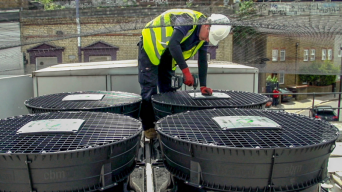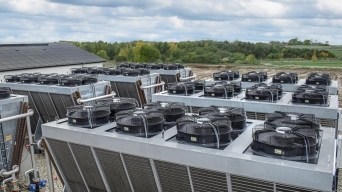Towards net zero emissions by 2050
AHU Retrofit, Singapore
UMC’s Singapore Wafer Fab Facility, located at 3 Pasir Ris Dr 12, Singapore 519528
Less is more
Hsinchu, Taiwan – Being the first semiconductor foundry to pledge net-zero, UMC has aggressive goals in its roadmap to attain net-zero emissions by 2050 [1]. Starting from 2020, UMC aims to achieve a 25 percent reduction in both direct greenhouse gas emissions and indirect emissions from electricity consumption by the year 2030. As the plants are always in operation round the clock, energy efficiency is always at the top of the mind for the semiconductor giant and remains a huge challenge to meet their sustainability goals. With these factors in consideration, UMC sought a ventilation technology solution that can help to reduce the power consumption for their air handling units (AHUs) while at the same time, improving the air efficiency for their Singapore wafer fab facility. While searching for a more efficient ventilation system, Mr Wayne Tan, UMC’s M&E Aircon System Engineer, got to learn about the benefits of EC fan systems and ebm‑papst. A leading brand in the World of Ventilation and Drive Technology, ebm‑papst is then shortlisted for its energy-efficient, intelligent solutions and extensive range of products. Under professional guidance and tight collaboration from ebm‑papst and a qualified installer partner, UMC successfully implemented the EC centrifugal fans in their facility.
EC centrifugal fans - A cost-effective solution that offers beyond higher efficiency
Before adopting ebm‑papst’s ventilation solution, UMC used the conventional AC belt-driven system with VSD which is less energy efficient, requires more maintenance work, and has no operational redundancy. With UMC’s sustainability goals in mind, the ebm‑papst team proposed ebm‑papst EC centrifugal fans which offer higher efficiency and lower power consumption. From a long-term perspective, ebm‑papst EC fans offer a cost-effective solution to UMC in the following ways:
RadiPac EC centrifugal fans in UMC's AHU
• Offering higher efficiency with minimal energy losses, achieved through its integrated designs where components are optimised for each other.
• 100 percent variable speed control via analog or serial interface. In EC fans, energy is used only when needed. The lowest possible speed for AC belt-driven fans is 25Hz, which is 50 percent of the speed range. This limits efficiency when operating at a lower frequency, leading to energy wastage.
• Eliminating the need for frequent maintenance as the motor, electronics, and impeller are integrated into the EC fan. Due to the integrated design, there is also no wear and tear issue which is common in belt-driven systems.
• Ease to retrofit due to its compact design which saves space and enables operational redundancy; multiple units can be installed in place of an AC belt-driven fan. The integrated and compact design where the electronics and motor form one unit also ensures easy installation, reducing the hassle of costly component matching on commissioning or for earthing and screening work.
• Long service life which helps to reduce operating and life cycle costs.
• Significant noise reduction as compared to AC fans.
• Future-proofing and scalability with ebm‑papst’s digital technology. After retrofitting their facility with ebm‑papst EC centrifugal fans, UMC is able to achieve up to 40 percent savings in energy.
Article by
Marketing Department of ebm‑papst SEA Pte Ltd
Published in Southeast Asia Building Sep-Oct 2022 Issue
References:
[1] “UMC’s climate goals validated by Science Based Targets initiative (SBTi)”, UMC, 2022, Retrieved from https://www.umc.com/en/News/press_release/Content/csr/20220623


